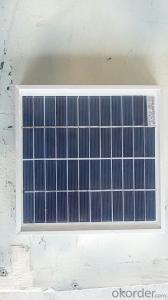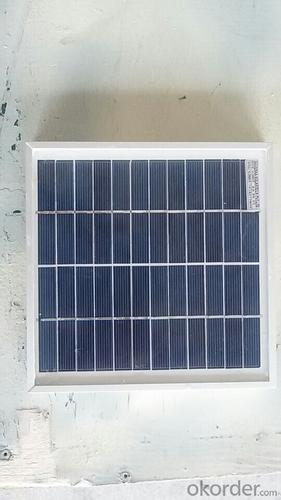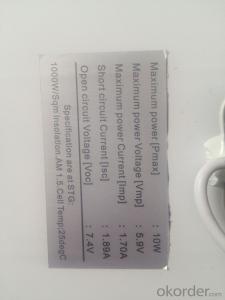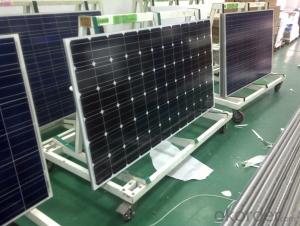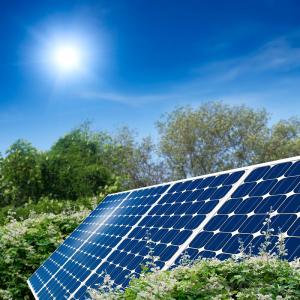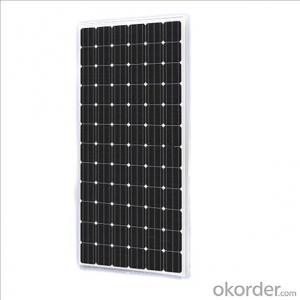Camper Roof Solar Panels - 20W Monocrystalline Solar Modules for Small Solar Systems
- Loading Port:
- Shanghai
- Payment Terms:
- TT OR LC
- Min Order Qty:
- 10000 watt
- Supply Capability:
- 50000000 watt/month
OKorder Service Pledge
OKorder Financial Service
You Might Also Like
Product Description
Solar Monocrystalline Series Panels
Introduction of Monocrystalline Solar Panels
CNBM Solar photovoltaic (PV) Panel is designed for large electrical power requirements. It is the optimal choice for both on-grid and off-grid power systems. CNBM Solar panel offers high performance of power per square foot of solar array. Monocrystalline silicon(c-Si): often made using the Czochralski process. Single-crystal wafer cells tend to be expensive, and because they are cut from cylindrical ingots, do not completely cover a square solar cell module without a substantial waste of refined silicon. Hence most c-Si panels have uncovered gaps at the four corners of the cells.
Characteristics of Monocrystalline Solar Panels
I Solar Cell : High efficiency crystalline solar cell. Even if under the weak light, the solar module can produce maximum power output.
II Tempered glass (toughened glass): Anti-reflecting coating and high transmission rate glass increase the power output and mechanical strength of solar module.
III EVA and TPT: Using high quality EVA and TPT to prevent destroying and water.
IV AI frame: Without screw, corner connection. 6 holes on the frame can be installed easily.
V Junction box: Multi function junction box with water proof.
VI Long lifetime: ≥25 years; Less power decrease
VII Good performance of preventing from atrocious weather such as wind and hails.
VIII Resisting moisture and etching effectively, not effected by geology.
Standard Test Conditions of Monocrystalline Solar Panels
The opto-electrical specifications shown below are stabilized values being measured at Standard Test Conditions, Irradiance: 1000W/m2, Spectrum: AM1.5 at 25°C, The info below is subject to manufacturing tolerances. Where appropriate minutes of measurement are available and are used for the dimensioning of the installation.
Advantages of Monocrystalline Solar Panels
1.High reliability with guaranteed -3% to +5% power output tolerance, ensuring return on investment
2. High conversion efficiency based on leading innovative photovoltaic technologies
3. Withstands high wind-pressure and snow load, and extreme temperature variations
4. Attractive appearance Unique frame design, high mechanical strength, and easy Installation
Characteristics of Monocrystalline Solar Panels
Max Power Voltage Vmp (V) | 17.8V | 18.2 V |
Max Power Current Imp (A) | 1.13A | 1.38A |
Open Circuit Voltage Voc (V) | 22.2V | 22.4V |
Short Circuit Current Isc (A) | 1.29A | 1.61A |
Max Power Pm (W) | 20W | 25W |
Temperature Coefficient of Cells
NOCT | 47℃±2℃ |
Temperature Coefficients of Isc (%/℃) | 0.06 |
Temperature Coefficients of Voc (%/℃) | -0.33 |
Temperature Coefficients of Pmp (%/℃) | -0.45 |
Mechanical Data Solar Monocrystalline Series
Power | 20W/25W |
Dimension | 650×290×25mm |
Weight | 2.2kg |
Tolerance | ±3% |
The dimension of the modules can be changed according to the demand of clients Limits.
Operating Temperature | –45 °C to +80°C |
Storage Temperature | –45 °C to +80°C |
Max System Voltage | 700V |
Guarantee Solar Monocrystalline Series Panels
Products Guarantee | 10 years free from defects in materials and workmanship |
Performance Guarantee | No less than 90% within 10yrs and no less than 80% within 25yrs |
Certificates | IEC, ISO, TUV, CE |
Package of Solar Monocrystalline Series Panels
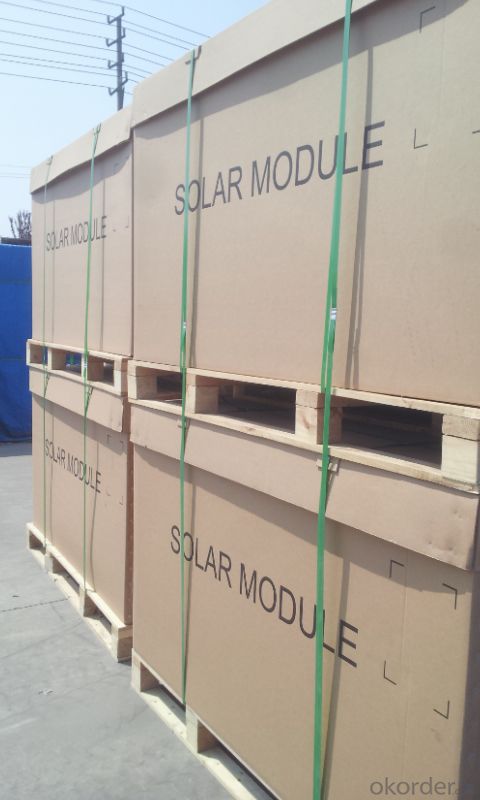

FAQ
We have organized several common questions for our clients,may help you sincerely:
1. What’s price per watt?
A: It’s depends on the quantity, delivery date and payment terms of the order. We can talk further about the detail price issue. Our products is high quality with lower price level.
2. Can you tell me the parameter of your solar panels?
We have different series of cells with different power output, both from c-si to a-si. Please take our specification sheet for your reference.
3. How do you pack your products?
We have rich experience on how to pack the panels to make sure the safety on shipment when it arrives at the destination.
4. What is your warranty system?
Our product performance guarantees for 25 years
• 12 years guarantee for workmanship
• Timeliness of delivery
• Quality Products certified (TÜV, UL, CE, ISO)
5. How do you pack your products?
We have rich experience on how to pack the panels to make sure the safety on shipment when it arrives at the destination.
- Q: Can solar panels be used for powering a manufacturing facility?
- Yes, solar panels can be used to power a manufacturing facility. Solar energy can be converted into electricity, which can then be used to power various processes and equipment in a manufacturing facility. This can help reduce reliance on traditional energy sources and promote sustainability. However, the feasibility and capacity of solar power for a manufacturing facility would depend on factors such as the facility's energy requirements, available space for solar panel installation, and local sunlight conditions.
- Q: I've been looking into solar panels. They are fairly expensive ($35k or so). My state has some rebates and grants available. Is anyone aware of any federal grants and rebates other than the federal tax credit? We are subject to AMT tax and can't take the credit. (Which is ridiculous, is the federal government committed to conservation or aren't they??????)
- Check out what someone did in Oakley, California - Contra Costa Times 22 June 2007 Going Solar Can Pay Off On The Long Run PGE Electric Power Monthly Bill Before Solar = $,200. Home: 2,900 sq. ft. Installation Cost for 6.7 Kilowatt 36-solar cells $46,000 (minus $7,60 State rebate). New Resources Bank, a “green” bank in San Francisco, lend them a, no-fee, no-points, second mortgage at $200 a month less than their previous monthly payments because of their plan to install solar panels. PGE Current Electricity Monthly Bill After Solar = $7.63 after deductions for any excess power produced by solar cell which PGE.is legally required to buy. PGE has not build any new electric power plants in California for years and their profits do not depend on sales volume, Sen. Feinstein introduced a bill to make this a National Law. Poweful interests are against this, perhaps they are foreign companies that hate Americans? Surely, they are not bona fide, red blooded Americans that love all the people in the U. S. of America, you think?
- Q: I have a solar energy panel that works in every room except mine. I have those severely bright, energy efficient bulbs and it doesn't work at all.What do I do? Is the bulbs really causing this? Why?
- get a voltage tester and test the output from the panel if it is a 24 volt output which is then inverted the reading should be that of the inverter. however if you solar panel installer installed an LCD panel that controls the electricity you can monitor any faults from the panel. Make sure that the panel you feel is not working is producing the same amount of electricity as the others. As for the bulb buy a new one from a different make and see what happens but by testing the output voltage and power you are bound to find the fault.. I have just thought of this the panels supply electricity to big batteries that then distributes power to all the house perhaps the battery supplying power to your room is faulty or the connections to the inverter might be faulty. BEST option if you can afford it because it will be expensive is to buy a solar monitoring system that control the panel and batteries you can even connect it to your laptop and control all the power.
- Q: Can solar panels be used in disaster relief efforts?
- Yes, solar panels can be used in disaster relief efforts. They provide a reliable and sustainable source of electricity, allowing for the operation of critical equipment such as lights, phones, and medical devices. Solar panels can be quickly deployed in affected areas and can help reduce the reliance on fossil fuel-based generators, thereby reducing pollution and the need for fuel transportation.
- Q: How much space do solar panels require?
- The space required for solar panels depends on several factors such as the power output of the panels and the efficiency of the solar cells. On average, a typical solar panel requires around 10-20 square feet of space. However, it is important to note that solar panels can be mounted on rooftops, installed in large solar farms, or even integrated into building materials, allowing for flexibility in their placement and utilization of available space.
- Q: What is the difference between Photovoltaic Panels and Solar Panels?
- Dear friend, Photovoltaic Panels and Solar Panels are the same products.
- Q: For example, how many large solar panels would you need to operate a greenhouse with lighting for simulate sun during cloudy weather, a scheduled sprinkle system and other such things?I'm looking for a very in depth answer.
- very hot it can attract the sun
- Q: I was watching an idiot abroad, and I saw a family that lived in tent like huts, with no plumbing. And they had a solar panel, now if they can afford it, I know I can. Where do you get cheap ones?
- you okorder . all you have to do is watch the video.
- Q: How do solar panels perform in cloudy weather?
- Solar panels do generate electricity even in cloudy weather, although their efficiency is reduced compared to sunny days.
- Q: How do solar panels affect the property's corporate social responsibility?
- Solar panels can positively impact a property's corporate social responsibility by reducing its carbon footprint and dependence on fossil fuels. By generating clean and renewable energy, solar panels help mitigate climate change and contribute to a more sustainable future. This proactive step towards environmental stewardship can enhance the property's reputation, attract environmentally conscious stakeholders, and align with the broader goals of corporate social responsibility.
Send your message to us
Camper Roof Solar Panels - 20W Monocrystalline Solar Modules for Small Solar Systems
- Loading Port:
- Shanghai
- Payment Terms:
- TT OR LC
- Min Order Qty:
- 10000 watt
- Supply Capability:
- 50000000 watt/month
OKorder Service Pledge
OKorder Financial Service
Similar products
Hot products
Hot Searches
Related keywords
